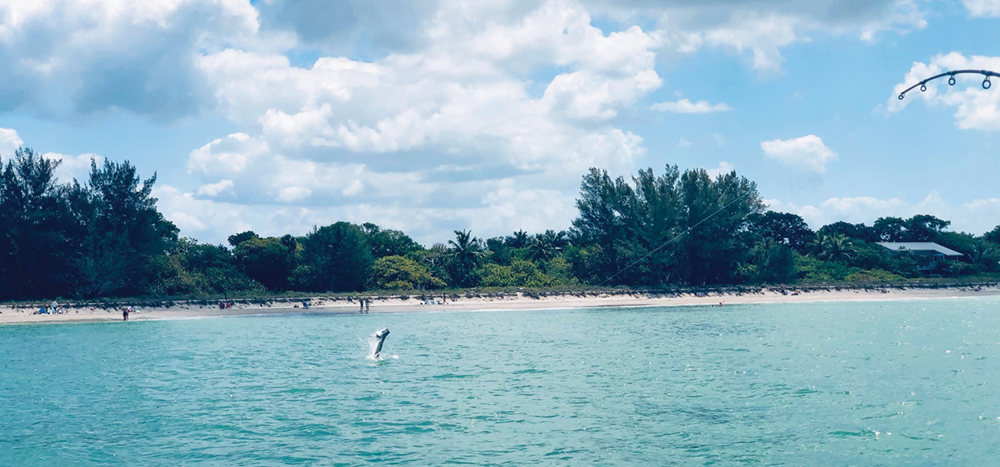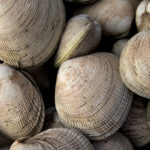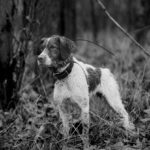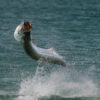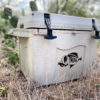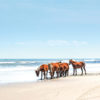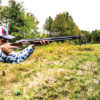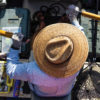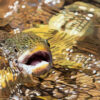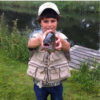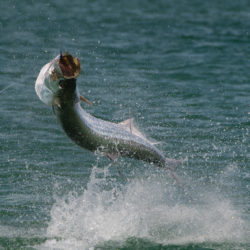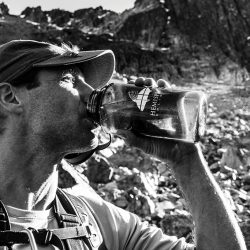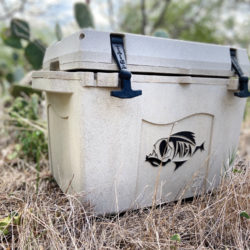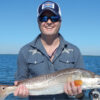APRIL 25
Over the years, I’ve witnessed Captain Jamie Goodwin toss a casting net. It may sound easy, but it’s not. Especially on a boat.
Hunter Reichert forgets that I’ve fished with Goodwin and have seen the guide in action, but it’s fun to humor my friend. We booked a two-day trip with the guide again last April targeting a variety of species in southwest Florida. Reichert only calls me by my first and last names, as if they are one designation.
“Joe-Shields, watch this guy cast a net,” Reichert said.
I’ve also been impressed by Goodwin’s ability to know where baitfish live, especially in the Pine Island Sound and the back bays of Gasparilla Sound. He knows the spots.
“Crabs are six bucks a piece,” Goodwin said. “Prices are crazy, like everything else. I’ve got some crabs in the baitwell, but we’ll see if we can get some threadfin.”
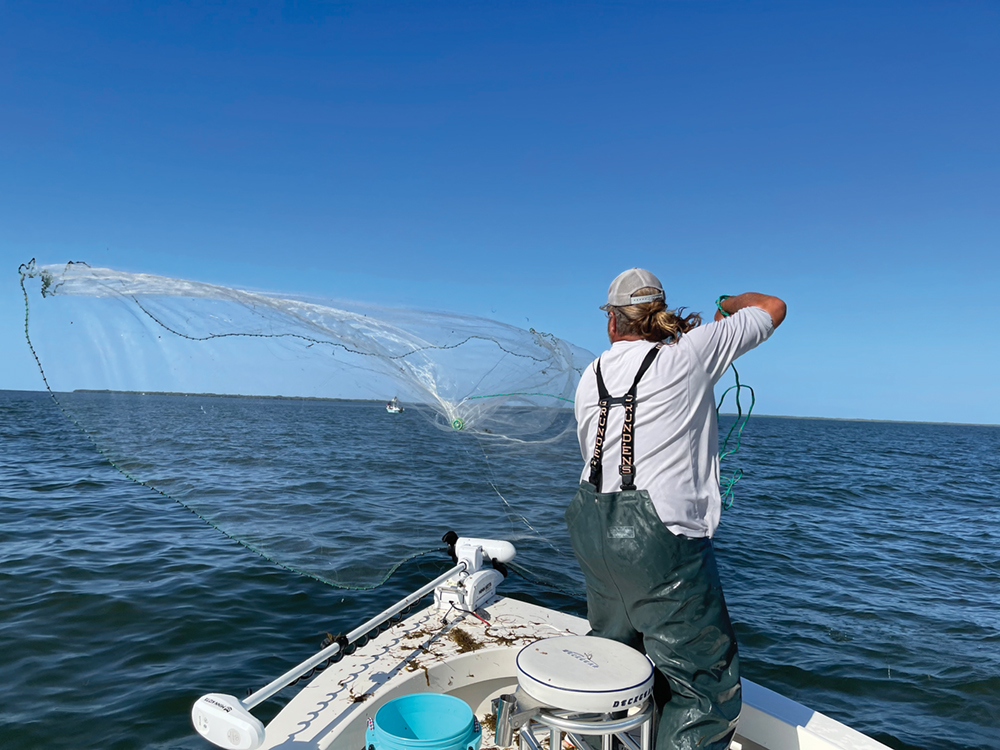
The guide hurled the net over the bow and released the weighted lead line and yoke in one smooth motion. The mesh monofilament and braille lines spread evenly into a ring before landing in the water and sinking. Moments later, Goodwin pulled the handline tight and hauled in baitfish. He repeated the process, and the well was full.
“We’ll see if the tarpon act weird today,” said the guide. “If they do, we’ll go after other fish this afternoon.”
Goodwin removed his waders and rinsed off the net and deck with fresh water. Then he climbed up the tower and started the engine.
Earlier that morning, we met Goodwin at the docks in front of the Pink Elephant on Bayou Street. I drove a golf cart to get there, and we zipped past homes in awe of the the royal poinciana trees that thrive in Boca Grande. Locals call them “tarpon trees” because they bloom in April and May, marking the beginning of tarpon season. Their scarlet and red-orange petals welcomed us as we whirled by.
Boca Grande is known as the “Tarpon Capital of the World,” but there is fantastic fishing for other species too. April 25 and 26 presented an intelligent plan for tarpon. The moon was supposed to yield strong outgoing tides that typically occur in late afternoon. The first quarter moon hit on April 20, my birthday, and the full moon was set to arrive on April 26.
These were good omens, but I’m all too familiar with a skunking. And that’s exactly what happened on the first day.
“You never know with tarpon,” Goodwin said. “That’s the beauty of this fishery. There are plenty of other fish to catch if the tarpon don’t eat.”
We motored passed Cabbage Key and its historic Dollar Bill Bar, which is wallpapered with more than 70,000 signed dollar bills from patrons. We casted crabs and waited for tarpon before sunrise. Goodwin spotted a few, but a bull shark suddenly appeared, and fish scattered.
Twenty minutes later, Reichert had the first catch—a baby hammerhead shark. Then I hooked a juvenile sharpnose shark. After an hour, we proceeded north, passing Useppa Island. Goodwin cut back the throttle and searched the waters for life we couldn’t find without him.
“That’s Mondongo Island,” he said, pointing west. “It’s privately owned.”
A large house sat on the eastern end of the island, along with cottages and a helipad.
We cruised northwest along the coast of Punta Blanca Island and Pelican Bay. Goodwin stopped the boat at Quarantine Rocks to show us reef-like formations that shoot off the point. The elongated slabs of natural limestone were perfect for Native Americans who built stick-dam entrapments to catch mullet. Then we crossed Boca Grande Pass, rounded Cayo Costa and headed south to the shoals, but still had no luck by 1 p.m.
“Do you guys want to catch snook?” Goodwin asked.
“That sounds like a good plan, Jamie,” said Hunter.
At 2 p.m. we anchored at the old phosphate dock, where they used to load processed phosphate onto ocean-going cargo vessels back when the railroad was active. When the tide is right, the snook bite is on, and we hauled in snook with every cast. They fought like crazy. We must have caught 30 fish between us. Reichert even caught a grouper.
We called it a day after four species and two hours of non-stop action.
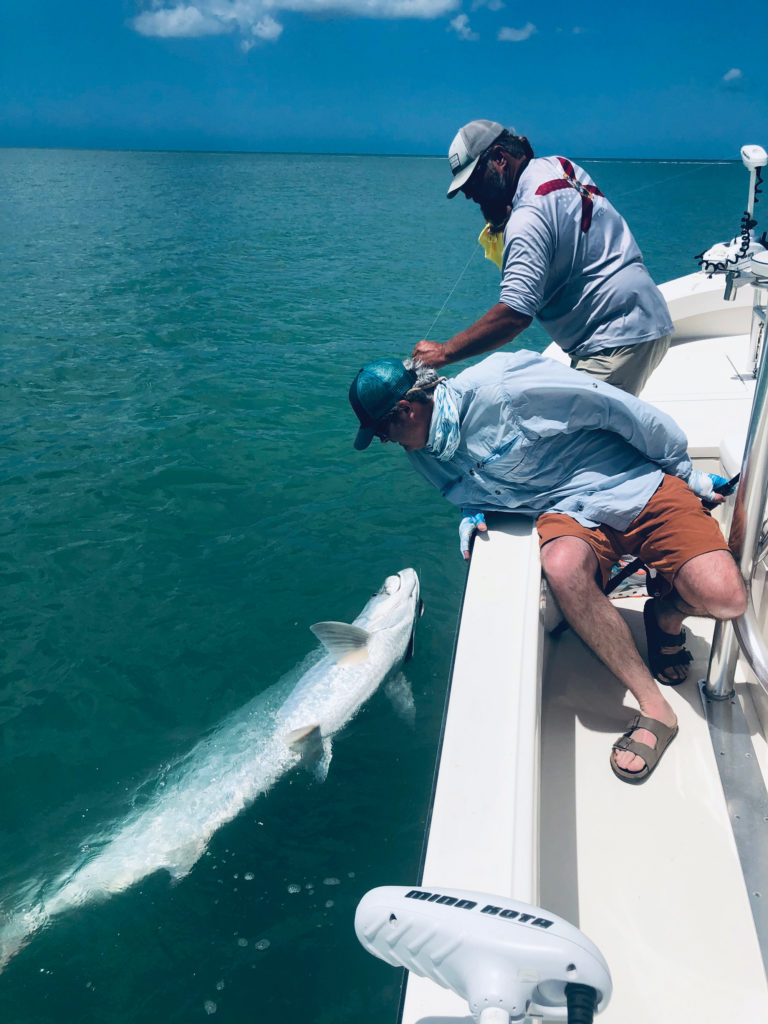
Florida fishing Guide Jamie Goodwin (standing) and the author take a moment to appreciate a 180-pound tarpon before releasing her into the Gulf of Mexico.
APRIL 26
The next morning resembled the first: calm; sunrise; banter. I caught a lemon shark. Then we headed south along The Narrows across Captiva Pass to North Captiva Island. We skirted the island and Foster Bay. Forty minutes later, we reached the Gulf of Mexico through Redfish Pass. We trolled offshore in front of a resort and casted crabs off the stern.
“Keep an eye on those strike indicators,” Goodwin said. “If they dip, start reeling.”
The sun was high, and I watched my crab swim in the current. I took my eyes off it for a second and looked at the beach.
“Joe, keep an eye on your rig.”
I turned and the indicator disappeared. Suddenly there was an explosion in the water. Goodwin climbed down from the tower and Reichert reeled in his crab.
“Here we go!” cried Goodwin. “It’s a big one.”
The fight lasted 45 minutes. I reeled feverishly when the Silver King fatigued; I let her run when she felt like it. The fish dragged us close to shore. Tourists on the beach left the shade of umbrellas and the comfort of chaise lounge chairs to watch the spectacle.
The fish dove and ran. She jumped three times. My arm burned. When I boated her, the sunlight beamed off her prehistoric scales. Purple, green and silver flashed through my polarized lenses. Goodwin released her back to the wild.
“She’s about 180 pounds,” estimated Goodwin. “That’s some fish.”
I cracked a beer and sat in the shade of the tower. Reichert casted, and moments later his reel began to sizzle.
“You’re turn, Hunter,” said Goodwin.
I couldn’t believe it.
Reichert boated a 160-pound tarpon. His fight mirrored mine, with three jumps and approximately 40 minutes of back-and-forth tug of war.
Satisfied with tarpon—and arm sore—we left Captiva and cruised to Bull’s Bay. Goodwin knew a little pass among the mangroves that was perfect for the tide.
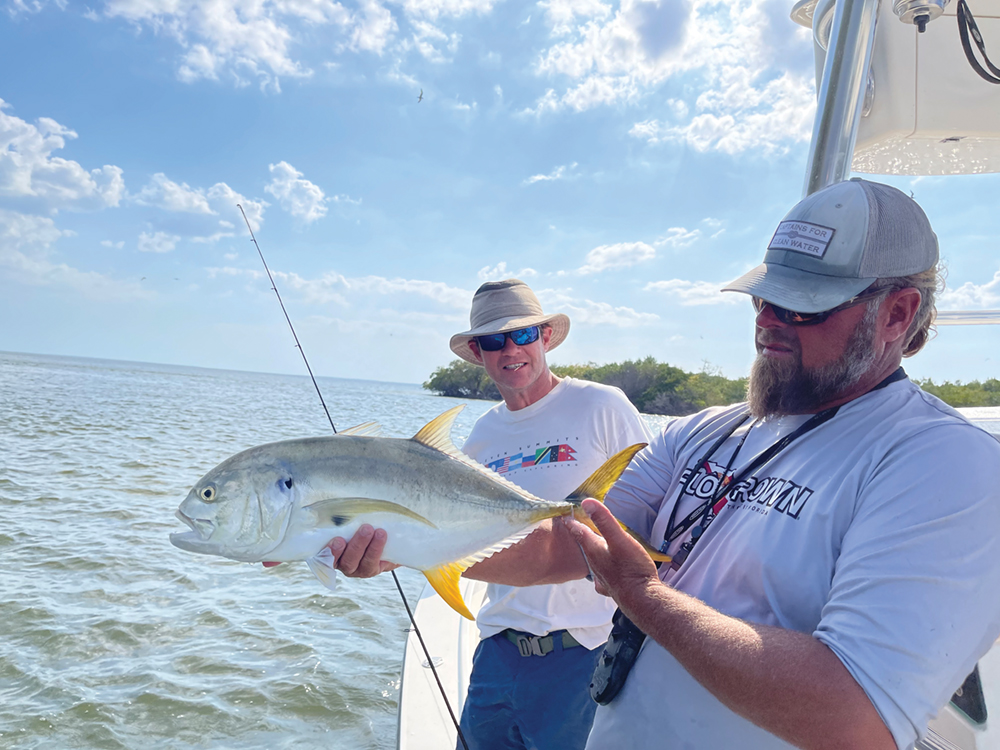
Within minutes, different species pounded threadfin. We caught more snook. Reichert pulled in a redfish. We both caught jacks. I caught a Spanish mackerel. Cast, retrieve, release. Cold beer. Rinse, repeat.
We decided to call it a day around 5:30 p.m. I placed my rod in the holder. Reichert made one more cast.
“I love it here,” I said. “The only species we might have missed is speckled trout.”
“This fishery is unique,” Goodwin agreed. “And it must be protected.”
All of a sudden, Reichert’s rod bent slightly, and he started to reel. Goodwin smiled.
“You’ve got to be kidding me,” he said, releasing the fish. Then he started the engine and drove us west into the sun.
Book a trip with Captain James Goodwin at gofloridafishing.com.
Joe Shields is the editor in chief of The Virginia Sportsman. He is a writer and digital marketing executive based in Charlottesville, Virginia. His writing and photography have appeared in The Virginia Sportsman and other publications. He is also an award-winning, gallery-represented artist whose work is found in private collections and galleries. Whether fly fishing or surfing, drawing or painting, he celebrates sporting life and culture in his narratives and art.
Cover photo: A tarpon makes a final jump during a 40-minute fight off Florida’s Captiva Island.

